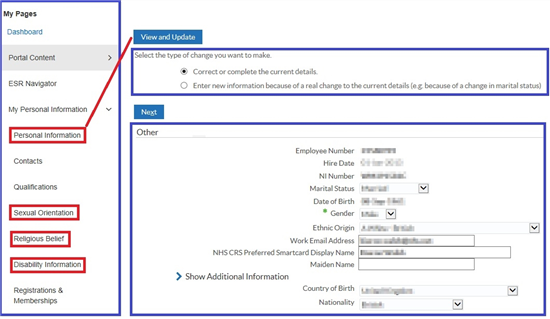Equality and Diversity - why your details are recorded
Under the terms of the Equality Act 2010 all Public Sector Employers, including the NHS, are obliged to ensure that employees are not discriminated against, harassed or victimised on the grounds of a number of Protected Characteristics. Furthermore under the Act there is a Public Sector Equality Duty whereby public bodies have to consider all individuals when carrying out their day-to-day work; in shaping policy, in delivering services and in relation to their own employees. It also requires that public bodies have due regard to the need to:
- Eliminate discrimination
- Advance equality of opportunity
- Foster good relations between different people when carrying out their activities
Recently introduced gender pay legislation requires employers with 250 or more employees to annually calculate and publish the pay gap between their male and female employees.
ESR enables the recording and reporting of data to help organisations demonstrate compliance with equality legislation. It also assists in comparing the experiences of staff in the Workforce Race Equality Standard (WRES) and Workforce Disability Equality Standard (WDES), and in determining action where necessary.
How can I view and amend my Equality and Diversity details?
Those with access to ESR Employee Self Service or Employee Self Service (Limited Access) can view or amend their own details by following the navigation paths as shown below:
ESR Portal > My ESR Dashboard

Note that pregnancy and maternity details cannot be entered by employees.
A number of online learning sessions have been created to demonstrate how to use Self Service to enter and maintain your personal details. Click here for details.
Data quality
Reporting on equality and diversity using ESR can be adversely affected by the proportion of blank entries or the selection of options such as ‘I do not wish to disclose’. You are urged to ensure that your personal record is fully populated with appropriate entries. Better data leads to better policies and better management decisions affecting the workforce.
Are all of the legally protected characteristics recordable on ESR?
The Equality Act 2010 covers the following ‘Protected Characteristics’:
| Age |
Disability |
Gender Reassigment |
| Marriage and Civil Partnership |
Pregnancy and Maternity |
Race |
| Religion or Belief |
Sex |
Sexual Orientation |
ESR enables the recording of details relating to each of the protected characteristics except Gender Reassignment, for which a decision on the question and potential responses to be made available is awaited from NHS England.
Note that Pregnancy & Maternity details are only recorded on ESR where there is an impact on employment:
- Pregnancy and maternity related absences are recorded.
- Employees receiving maternity pay are given an assignment status of ‘Maternity & Adoption’.
- Where the nature of a person’s job leads to a change of duties during pregnancy an appropriate reason for the change of assignment is recorded.
Are there plans to change the Equality and Diversity details recorded in ESR?
A review of the protected characteristics is currently being undertaken by NHS England. This review covers data sets used across the NHS, not just ESR, in relation to the workforce and to patients.
Work already underway
- Sexual Orientation - Revised classifications have been published as an independent Standard and these are targeted for implementation in ESR Release 39 (end of June 2018).
- Disability - Work has begun in this area which may also lead to an independent Standard.
- Universal Standard - NHS England are considering the merits of creating a single universal standard covering all of the protected characteristics. This would incorporate any previously agreed independent Standards. The relative cost and impact on the service of an incremental versus a ‘big bang’ approach is being assessed.
When will the review be completed?
NHS England has announced that any proposed change to the NHS datasets will need to take account of the 2021 Census which is managed by the Office for National Statistics. A white paper regarding the proposed content of the Census, including equality and diversity details, will be put to Parliament in late 2018/early 2019. The intention is that, where appropriate, NHS datasets should be compatible with the Census data.
Will changes be made to ESR ahead of the wider review?
Although it would be possible to implement changes to the values in ESR independently of NHS England’s review, there is a high risk that any such changes would be rendered obsolete when that review is complete. So at present there are no plans for ESR to implement changes ahead of the published review findings.
Next steps
When NHS England concludes its data set review and a new Standard, or equivalent, is produced, NHS Digital will begin the process to reflect the revised content in the National Workforce Dataset.
In order to minimise further delay NHS Digital have indicated that they may allow systems such as ESR to implement the required changes whilst the process to formally publish a revised National Workforce Dataset is underway. This approach was recently taken with the implementation of the Sexual Orientation Monitoring Standard.
NHS Digital will publish formal announcements regarding changes to the data sets on their website. Users of ESR will be advised of changes and implementation dates through the usual channels including Release Notices and User Group meetings.